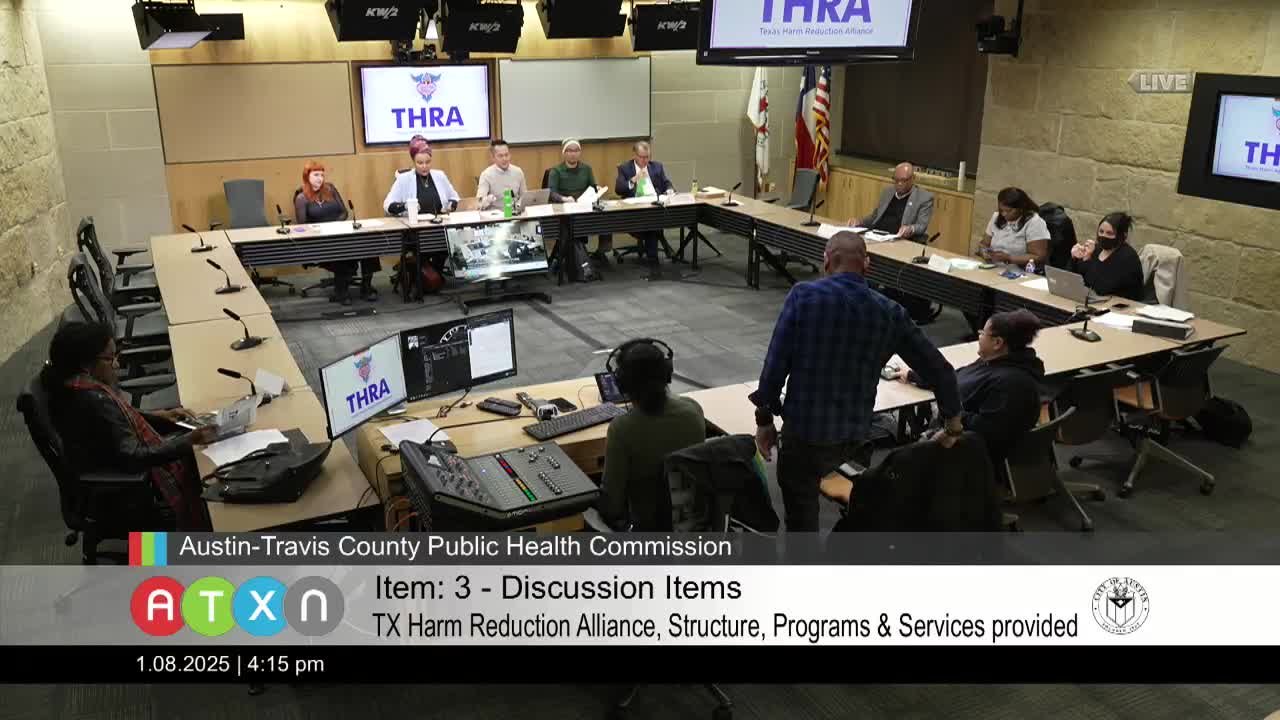Texas Harm Reduction Alliance details services, asks commission to help secure funding, beds and data support
January 08, 2025 | Austin, Travis County, Texas
This article was created by AI summarizing key points discussed. AI makes mistakes, so for full details and context, please refer to the video of the full meeting. Please report any errors so we can fix them. Report an error »

Maggie Luna, executive director of Texas Harm Reduction Alliance (THRA), and Steven Smith, THRA reentry lead, described the organization’s services, outreach model and urgent needs during a presentation to the Austin–Travis County Public Health Commission.
THRA’s work and model: Luna said THRA grew from efforts to address rising opioid overdose rates and now operates a drop-in center at 1803 East Cesar Chavez, a mobile clinic with showers and a multi-person outreach team. "Those who are closest to the problem are closest to the solution," Luna said, describing THRA’s peer‑led staffing and the organization’s focus on providing nonjudgmental services, overdose prevention training and wound care. Smith described reentry work that connects people leaving jail to housing and treatment; he said THRA follows people from jail into the community to improve continuity of care.
Services and scale: Speakers said THRA has 17 staff on payroll; the drop‑in center sees over 100 distinct people per day; outreach and drop‑in teams each number roughly four staff; the reentry team is three people. The mobile clinic provides on‑site wound care, showers and testing; THRA said it gave out naloxone widely, provides HIV testing weekly and offers targeted services such as women’s programming and acupuncture. THRA also reported losing a contract with a provider that had supplied hot meals and described providing packaged food, snacks and survival items as available funds allow.
Needs and barriers: THRA asked for support on several fronts. Staff said they need more outreach capacity (additional vans and staff), more transitional housing beds for people leaving custody, capacity to produce data and reports (THRA has operational numbers but lacks staff for qualitative reporting), and stable funding for meals and operations. Luna and Smith described legal and funding constraints: they said government funding presently cannot be used to provide certain safe-use supplies because of paraphernalia rules, and that fentanyl/xylazine test strips and other items are difficult to fund through some public grants.
Commission response and follow up: Commissioners thanked THRA for its work, asked for a budget breakdown and for the organization’s view of a scaled model (what staffing and vehicles would look like at scale). THRA said it would provide a budget and a “vision” document outlining preferred staffing and vehicle levels. Commissioners discussed potential paths to support THRA’s needs through grant guidance and budget recommendations, and flagged the need to identify funding streams that can legally support safer‑use supplies or alternative approaches while state law and funding rules evolve.
Legal context: THRA and commissioners noted Texas law and funding restrictions as impediments to some safe‑use supplies, and noted there is at least one bill proposed in the Texas legislature addressing related issues.
Ending: The commission invited THRA to share its budget breakdown and data products with staff for distribution to commissioners and discussed possible future collaboration on training and shelter/cooling‑center partnerships.
THRA’s work and model: Luna said THRA grew from efforts to address rising opioid overdose rates and now operates a drop-in center at 1803 East Cesar Chavez, a mobile clinic with showers and a multi-person outreach team. "Those who are closest to the problem are closest to the solution," Luna said, describing THRA’s peer‑led staffing and the organization’s focus on providing nonjudgmental services, overdose prevention training and wound care. Smith described reentry work that connects people leaving jail to housing and treatment; he said THRA follows people from jail into the community to improve continuity of care.
Services and scale: Speakers said THRA has 17 staff on payroll; the drop‑in center sees over 100 distinct people per day; outreach and drop‑in teams each number roughly four staff; the reentry team is three people. The mobile clinic provides on‑site wound care, showers and testing; THRA said it gave out naloxone widely, provides HIV testing weekly and offers targeted services such as women’s programming and acupuncture. THRA also reported losing a contract with a provider that had supplied hot meals and described providing packaged food, snacks and survival items as available funds allow.
Needs and barriers: THRA asked for support on several fronts. Staff said they need more outreach capacity (additional vans and staff), more transitional housing beds for people leaving custody, capacity to produce data and reports (THRA has operational numbers but lacks staff for qualitative reporting), and stable funding for meals and operations. Luna and Smith described legal and funding constraints: they said government funding presently cannot be used to provide certain safe-use supplies because of paraphernalia rules, and that fentanyl/xylazine test strips and other items are difficult to fund through some public grants.
Commission response and follow up: Commissioners thanked THRA for its work, asked for a budget breakdown and for the organization’s view of a scaled model (what staffing and vehicles would look like at scale). THRA said it would provide a budget and a “vision” document outlining preferred staffing and vehicle levels. Commissioners discussed potential paths to support THRA’s needs through grant guidance and budget recommendations, and flagged the need to identify funding streams that can legally support safer‑use supplies or alternative approaches while state law and funding rules evolve.
Legal context: THRA and commissioners noted Texas law and funding restrictions as impediments to some safe‑use supplies, and noted there is at least one bill proposed in the Texas legislature addressing related issues.
Ending: The commission invited THRA to share its budget breakdown and data products with staff for distribution to commissioners and discussed possible future collaboration on training and shelter/cooling‑center partnerships.
View full meeting
This article is based on a recent meeting—watch the full video and explore the complete transcript for deeper insights into the discussion.
View full meeting
